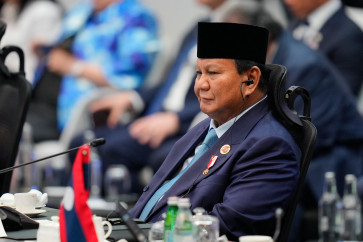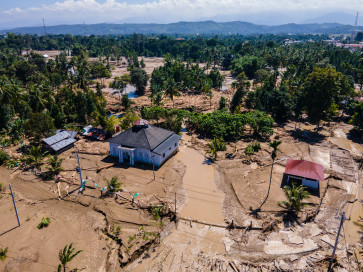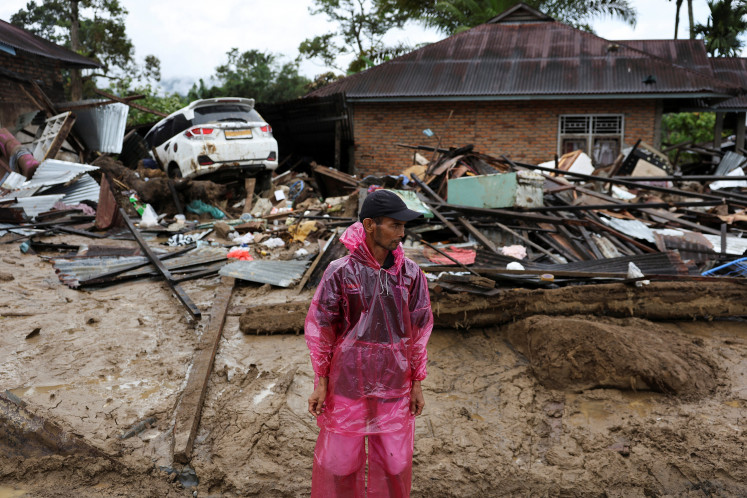Popular Reads
Top Results
Can't find what you're looking for?
View all search resultsPopular Reads
Top Results
Can't find what you're looking for?
View all search resultsFlood-prone areas increase in Tangerang
Against the current: A Public Order (Satpol PP) officer and residents help motorists pass the flooded Cipinang River in Kampung Makasar, East Jakarta, on Tuesday
Change text size
Gift Premium Articles
to Anyone
 Against the current: A Public Order (Satpol PP) officer and residents help motorists pass the flooded Cipinang River in Kampung Makasar, East Jakarta, on Tuesday. The river broke its banks after a surge of water from upstream in Bogor, West Java. (JP/P.J. Leo) (Satpol PP) officer and residents help motorists pass the flooded Cipinang River in Kampung Makasar, East Jakarta, on Tuesday. The river broke its banks after a surge of water from upstream in Bogor, West Java. (JP/P.J. Leo)
Against the current: A Public Order (Satpol PP) officer and residents help motorists pass the flooded Cipinang River in Kampung Makasar, East Jakarta, on Tuesday. The river broke its banks after a surge of water from upstream in Bogor, West Java. (JP/P.J. Leo) (Satpol PP) officer and residents help motorists pass the flooded Cipinang River in Kampung Makasar, East Jakarta, on Tuesday. The river broke its banks after a surge of water from upstream in Bogor, West Java. (JP/P.J. Leo)
A
span class="caption" style="width: 496px;">Against the current: A Public Order (Satpol PP) officer and residents help motorists pass the flooded Cipinang River in Kampung Makasar, East Jakarta, on Tuesday. The river broke its banks after a surge of water from upstream in Bogor, West Java. (JP/P.J. Leo)
The number of flood-prone areas in Tangerang, Banten, has increased significantly over the past year, making programs to normalize four rivers flowing through the satellite city a top priority, an official says.
Tangerang Mayor Arief R. Wismansyah said on Tuesday that the figure had risen to 55 spots this year from 13 a year before.
'The increase was caused by four rivers that overflow every time it rains heavily. The four rivers comprise the Cisadane, Sabi, Angke and Ledug,' he said, adding that he had encouraged the Public Works Ministry, which oversees the rivers flowing through a number of regions, including Jakarta and Tangerang regency, to dredge the rivers.
'The minister has agreed and promised to follow up in the near future,' he said.
The ministry completed a dredging project in the Cisadane River in Tangerang in 2009, but the project was only carried out along 2 kilometers of the 12-km section of the river that flows through the city.
Another dredging project was also carried out on the Sabi River in 2011, but only 40 percent of the total length flowing through the city was dredged.
Arief said his administration had allocated Rp 200 billion (US$16.4 million) to tackle flooding in the city.
'The budget will be used to dredge the Angke River, to build sheet piles and drainage, procure pumps and so on,' he pointed out.
Even though the ministry agreed to put the dredging projects on its to-do list this year, it also acknowledged that a few challenges could hamper its effort to expedite completion.
The ministry's Ciliwung and Cisadane rivers control office head T. Iskandar said that the presence of squatters had hampered the project.
'We started dredging the Ciliwung River in December, but the presence of squatters occupying the riverbanks hampered the project,' he said after a meeting with Governor Joko 'Jokowi' Widodo at City Hall, citing Kampung Pulo in East Jakarta as one of the areas densely occupied by squatters.
He said the ministry aimed to expand the river's width to 50 meters from the current 20 to 30 m. It also plans to build inspection roads on the riverbanks.
'It is the city administration that is authorized to relocate the squatters. We hope it can be done soon,' he said.
Meanwhile, Jokowi encouraged East Jakarta Mayor Krisdianto to make a list of squatters to be relocated from the area affected by the dredging project.
'Three low-cost apartments in Cibesel, Komarudin and Jatinegara have been prepared to accommodate them,' Jokowi told reporters.
Meanwhile, while most people displaced by flooding had returned home by Tuesday, a number of neighborhoods in Kampung Makasar, East Jakarta, experienced inundation caused by a collapsed section of an emergency embankment at the Cipinang River.
The emergency embankment, which was in the form of sandbags, was damaged several times over the past two months.
The Jakarta Disaster Mitigation Agency (BPBD) reported on Tuesday evening that the number of evacuees reached 9,368, decreasing from the 21,891 people reported on Monday. The evacuees were
sheltered in 26 locations.
According to the BPBD, floodwater in Central, West and North Jakarta has receded. Thirteen subdistricts in five districts in East Jakarta were still inundated by 30 to 100 centimeters of floodwater, while inundation in two subdistricts in South Jakarta was between 50 and 150 centimeters.
Meanwhile, an evacuee reportedly died in East Jakarta.
'A 67-year-old resident of Gang Arus in Cawang reportedly slipped and fell in a bathroom in an evacuation shelter. We are still waiting for confirmation,' Rendra, a BPBD staff officer, told The Jakarta Post on Tuesday.
He said he had not received confirmation from the subdistrict office by the evening. Cawang subdistrict head Ompu Mochamad Taufik did not return the Post's text message and calls.
To date, the official death toll from the floods is 23. Last year, 27 people died in flooding that hit the capital city in the middle of January. Last year's flood affected 250,000 people in 102 subdistricts and displaced 40,425 people.
On Jan. 22 this year, the floods displaced 89,334 people in 99 subdistricts.
Indah Setiawati contributed to the article.









